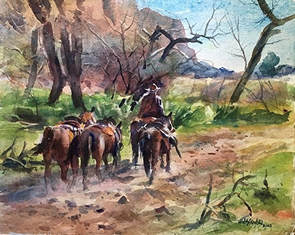Watercolor à la Jimmy Wisnowski
by Angela Alvarenga

James Wisnowski gave a beautiful and instructive demonstration on how he creates a painting. He enjoys working on 300 pound handmade watercolor paper. After he has roughed out his thumbnail for the best composition, he starts with a light pencil sketch. Between his thumbnail and light pencil sketch phases, he can recompose the layout by referencing his photograph in order to decide what he needs in the painting and how the eye will move along the pattern. He advises that you know as much as possible before starting a painting to avoid having to go back and make adjustments. He believes the difference between a photograph and a sketch is that a sketch can be simplified. He works from large, medium to small, and then light to dark. He confidently blocks in the darks as soon as possible but does not try to build them up. He completes his paintings by adding in the small darks.
Wisnowski's palette may look like a big puddle of mud, however his paints are strategically organized from warms to cools. When mixing the colors, he brings in warm colors first and then moves along the palette to the cool colors. He reminded us that the warm will bring the subject and the focal point towards the viewer, while the cool will move the viewer's eye away.
Over time teaching classes, he has recognized 3 stages as a student develops in their art: First, copying—learning to draw shapes and capture values. It is a non-creative part of painting and slightly mathematical. Second, composition—a term found in every art form. How the viewer's eye moves around an art piece, noticing patterns and the center of interest. Third, statement—regardless if the piece is abstract or representational, what is the artist trying to say in their piece? It is important to say one thing.
Wisnowki paints using one of 6 classical compositions: the "S" Shape Pattern, the Circle Pattern, the "L" Pattern, the Pyramid, Lines (background, foreground, mid-ground) and Light Over Dark. He also shared a tip on achieving a bold center of interest by the use of a value scale. Make a value scale with 9 being the darkest and 1 being the lightest. Make your center of interest have the 9 value right next to the 1 value. This will give the utmost contrast. He explains that a 5 value next to a 1 value does not offer enough contrast for the center of interest. Lastly, interesting shapes can also contribute to a strong center of interest, such as multiple squares next to one triangle.
During the demo he also talked about his Adventure Painting Workshops. He recently returned from a workshop in Italy and France. A typical day in a workshop would start with breakfast by 7am, head out by 8:30am and be set up by 9:30am. He encourages the group to complete 2-3 paintings a day with 1-2 hours per painting. The group finishes by 5pm and then back to the hotel for dinner. The group stays in one location for a few days but will travel to 3-4 locations for the entire workshop. He said no matter what, at the end of the trip the group can always agree that the painting was wonderful, but the food was brilliant! For more info on his classes or travel workshops visit his website https://jameswisnowski.com
Wisnowski's palette may look like a big puddle of mud, however his paints are strategically organized from warms to cools. When mixing the colors, he brings in warm colors first and then moves along the palette to the cool colors. He reminded us that the warm will bring the subject and the focal point towards the viewer, while the cool will move the viewer's eye away.
Over time teaching classes, he has recognized 3 stages as a student develops in their art: First, copying—learning to draw shapes and capture values. It is a non-creative part of painting and slightly mathematical. Second, composition—a term found in every art form. How the viewer's eye moves around an art piece, noticing patterns and the center of interest. Third, statement—regardless if the piece is abstract or representational, what is the artist trying to say in their piece? It is important to say one thing.
Wisnowki paints using one of 6 classical compositions: the "S" Shape Pattern, the Circle Pattern, the "L" Pattern, the Pyramid, Lines (background, foreground, mid-ground) and Light Over Dark. He also shared a tip on achieving a bold center of interest by the use of a value scale. Make a value scale with 9 being the darkest and 1 being the lightest. Make your center of interest have the 9 value right next to the 1 value. This will give the utmost contrast. He explains that a 5 value next to a 1 value does not offer enough contrast for the center of interest. Lastly, interesting shapes can also contribute to a strong center of interest, such as multiple squares next to one triangle.
During the demo he also talked about his Adventure Painting Workshops. He recently returned from a workshop in Italy and France. A typical day in a workshop would start with breakfast by 7am, head out by 8:30am and be set up by 9:30am. He encourages the group to complete 2-3 paintings a day with 1-2 hours per painting. The group finishes by 5pm and then back to the hotel for dinner. The group stays in one location for a few days but will travel to 3-4 locations for the entire workshop. He said no matter what, at the end of the trip the group can always agree that the painting was wonderful, but the food was brilliant! For more info on his classes or travel workshops visit his website https://jameswisnowski.com
